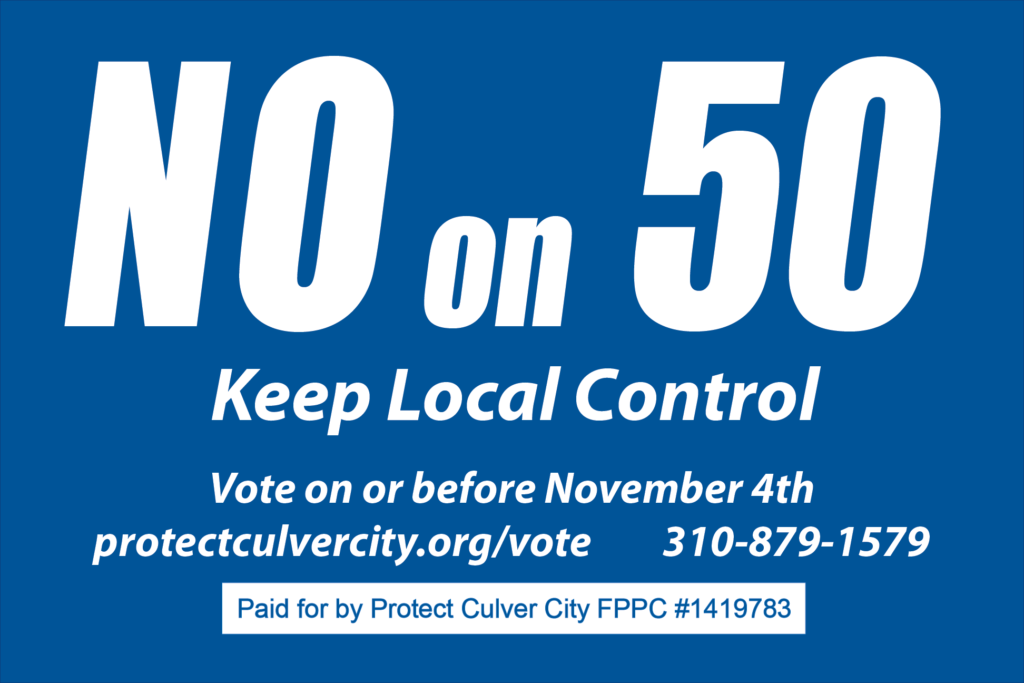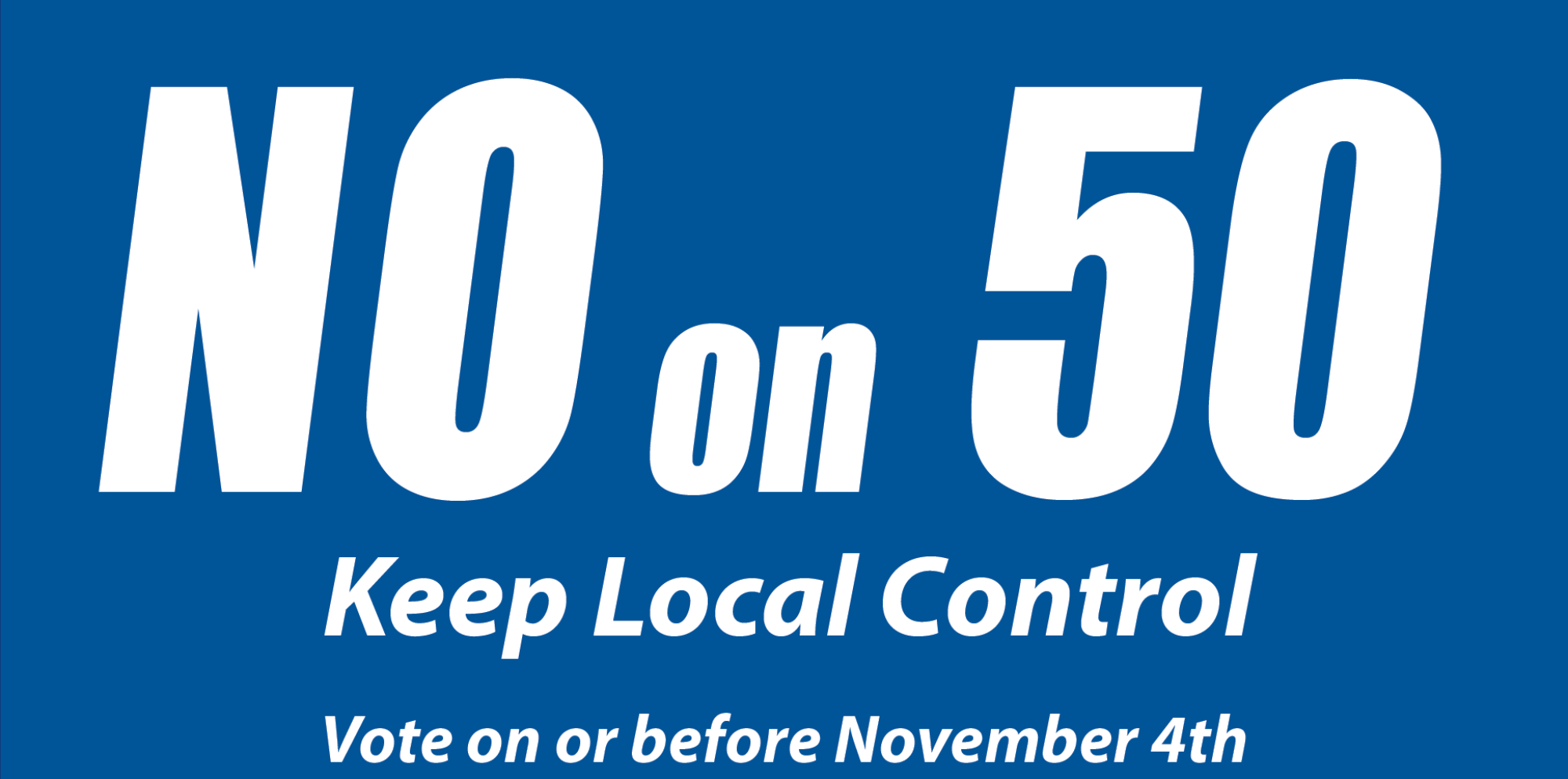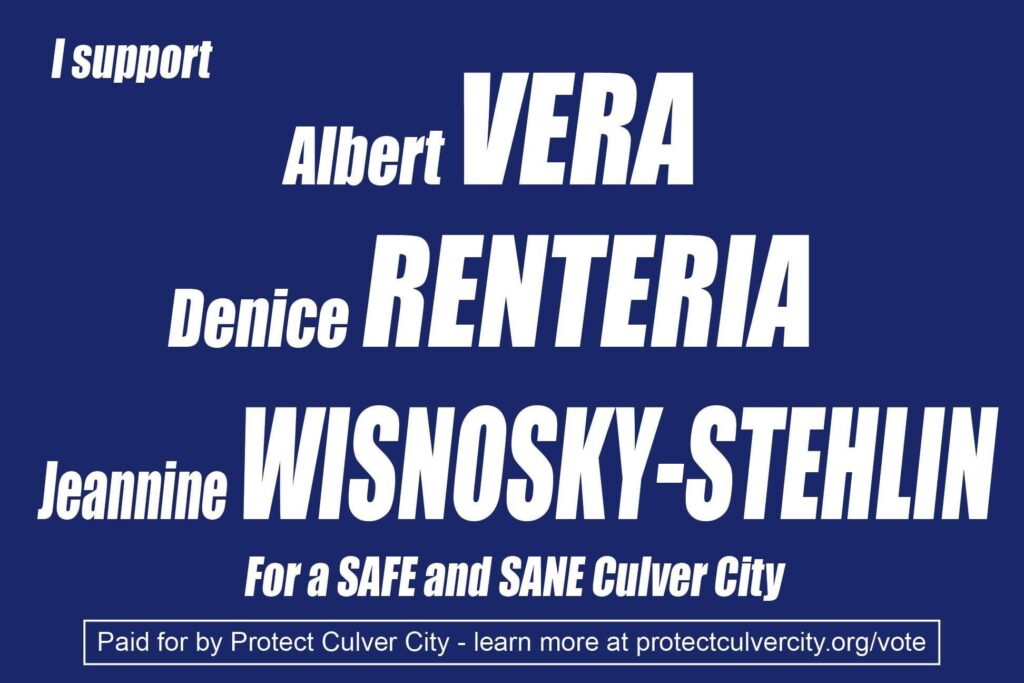Getting past a bad faith Council
Protect Culver City was founded in July 2019 in response to Council passing rent control. It wasn’t that they passed rent control, but how they passed it, that was cause for concern. An issue nobody ran on, with no discussion, passed in the dead of night, over some unfounded pretext of an epidemic of evictions and gouging. Based on this, we knew rent control would not be our only or even primary issue. We need to take on the housing debate, and a bad faith council in general, if we were going to turn around this city. Since then, we’ve been involved in the following issues:
- Defending our police department – both their reputation and budget
- Raising the public safety and health issue of homeless camps
- Educating voters on Council’s upzoning plans
- Keeping an honest debate on housing affordability, and questioning the effectiveness of rent control
- Keeping voters aware of other issues that come up, such as the SEIU pay increase
In the 3.5 years since, our efforts have been more than vindicated. For the first time, we have a majority on our Council that will listen to us. But the bad faith elements remain – yes in the Council minority, but more so in their supporters. Here’s what we’re seeing and where we’re going as a city.
The New Council: promises made, promises kept
The new council was sworn in December 12th and wasted no time getting to work undoing the damage of the previous council. They immediately convened a special council meeting on the 21st to discuss an anti-camping ordinance for Culver City, mirroring the ordinances at Santa Monica, Beverly Hills, and Los Angeles. Staff has been instructed to draft this ordinance to be voted on January 23rd meeting, and will be implemented sometime in late February. This will coincide with Los Angeles’s emergency declaration on homelessness, and will serve to ensure transients don’t simply cross city lines to find a more lenient place to live.
Council has promised a few things about any prohibition on camping in Culver City:
- Nobody will be arrested or cited for being homeless.
- Nobody will be forced to move unless we have shelter available for them.
- This ordinance is slated to go into effect at the same time our Homekey hotels go online, promising plenty of available beds for anybody who needs it.
There are some exceptions to these promises. Camping in Culver City parks has always been illegal. Those who try to camp here will always be moved out, regardless of other conditions. The city also reserves the right for “sweeps”: in this case, getting street campers to pick up their belongings, temporarily, while the city “sweeps” the sidewalk. This fulfills a basic duty of sanitation for campers and residents alike. Once sanitation workers have completed their duties, the campers are free to return.
This fulfills the legal requirement of Martin vs. Boise – that no anti-camping ordinance shall be enforced if the city doesn’t have a place to send people. And that’s the issue we pushed during our campaign: “if we have some where to send them, but they don’t want to go, can we compel them?” Council has even gone a step beyond the basic requirement of shelter. Our shelters are actually better understood as “navigation centers” – temporary spots for people as we figure out permanent housing for them.
We go well above and beyond Martin v Boise requirements because it’s such a contentious issue, with dark money lawfare firms ready to sue the city at the slightest opportunity. Meanwhile, activists answer the above question with a resounding “NO, WE CANNOT.” They envision a purely voluntary method for getting people into shelter and housing. If they don’t want to move, we can’t touch them. This philosophy got us to where we are today.
These activists constitute two of our councilmembers – Freddy Puza and Yasmine Imani-Mcmorrin, as well as several commissioners like Stephen Jones and Nancy Barba.
It would be one thing if we could have a good faith philosophical disagreement about how to handle homelessness and street camping. Unfortunately, activists are being deceptive about the whole debate. They make out “sweeps” to be some kind of mass arrest, envisioning stormtroopers descending on a camp at 4am and marching people off to concentration camps in Palmdale.
This is ludicrous, and Councilmembers have said none of this is happening. But activists make this accusation as a dodgy attempt to get a promise from Council that they will do no sweeps. But rest assured – when they say “sweeps”, they mean exactly what we mean. They are trying to push councilmembers to agree to never touch a camp unless the occupants willingly move.
Transient Camps, Homelessness, and Housing Affordability
Behind this voluntary philosophy on our camps is the basic contention that housing is unaffordable. Fix affordability, and our transient camps will go away. Without that, there’s nothing we can do about them.
On the surface, they have a point. The new developments Council has approved go for multiple times what historic multifamily units go for. We called attention to this during our Measure B campaign “which way, Culver City?” We pointed out in 2020 that a typical multifamily 2br went for $2000, while a new development “stack n pack” 2br went for $4500+. This latter number continues to skyrocket, dragging multifamily rents along with it. Meanwhile, Council’s “affordable” unit stipulations and overlay provide a questionable amount of housing to offset this.
Councilmember Puza said on the dais that rent control helped stop homelessness. This was a disingenuous argument. The homeless we see in Culver City are not locals driven out by rising rents. The debate on the transients we do have is whether they can be indoors at all. The housing and shelters we provide must come with wraparound services which include addiction treatment.
Meanwhile, Council’s rent control plans were a solution looking for a problem – and are punitive towards multifamily owners. The more conspiratorially minded would think that it was designed to drive older multifamily properties off the market, leaving only newer developments to rent from.
Whether the intention is there or not, we believe that punitive measures on our most affordable housing will only make the problem worse. Meanwhile we’d like to work with Council to come up with better solutions to offer everyone a chance to live in our city at an affordable rate. Our rent control administration comes at a cost of $1.5 million a year. This money could be much better spent expanding our Section 8 program or offering other means testing methods to offer affordable housing.
But multifamily housing needs to be protected and nourished as the last affordable housing at the scale we need.
Police, Zoning, SEIU – the common factor
Let’s clarify right away. Each one of these issues was a separate campaign for us, with its own budget. Lumping them together does not make them any less important. In fact we quickly found our Defend Don’t Defund CCPD campaign of the 2020 season quickly eclipsed our Measure B campaign. This campaign gave shape to our opposition. Nearly 80% of Culver City residents may support CCPD – but they quickly found that making their support public earned the fury of the activists. We had so many signs stolen we wound up on the evening news. The Knock LA blog wrote the hitpiece on us, saying we ran a racist intimidation campaign – when the only vandalism was against us.
But they attacked us because we were effective. This campaign punctured the halo of the progressives. For the first time, voters realized voting for them could cause real permanent damage to our city. We believe this campaign helped turn things around and set the stage for 2022.
The zoning issue was a bit more complicated for us. Since most of us are multifamily owners, ending single family zoning didn’t hit us as personally as it did homeowners. But again, it’s how Council approached this debate that raised the alarm. They put in the minimum outreach they could get away with. They used loaded words to claim anyone who opposed eliminating single family was a racist throwback to a segregated Culver City.
We did our best to get out accurate information to residents. But we were happy to take a back seat to emergent city groups like Culver City Neighbors United. Not just because it took the burden off of us. But it was a sign more residents were waking up to the bad faith tactics of the Council majority. That allowed everyone to work in parallel to flip that third seat away from the activist slate.
Not to be outdone, the SEIU has been pushing all last year to get a pay increase for their workers at Brotman Hospital through Council fiat. They’re couching this in a “minimum wage for health care workers” – which would go slightly beyond them. But considering Brotman is the only hospital in town, it basically hits their employees the most.
SEIU has spent over $400,000 in PAC money on this goal – and that’s only until June of this year. This figure alone already matches everything Hackman spent on the election, and they’re continuing to spend money to bully our current city council to pass this law. While our activist friends have sounded the alarm about Hackman’s money, they have been completely silent about this.
The exiting council passed this law while the incoming council waited to be inaugurated – an unprecedented move. Once the new council took the dais, they reversed the decision, saying it’s not Council’s position to declare wages in this city, that SEIU needs to do collective bargaining to get the wages they want for their workers. Council also did this to avoid another lawsuit from the hospital.
We’re already seeing deceptive mailers from SEIU asking people to bully the new council into passing their law. They mailer claims the new council “cut their pay.” Nobody’s pay was cut. Council reversed a decision that never went into effect.
Again, this shows the deeper issue in our city. Working in the interests of residents may seem like a no-brainer – but it also gets the opposition of some powerful and well-funded outside interests.
Activists? Progressives? Who are they, and what do we call them?
Ultimately these activists reflect a tiny minority of people who actually live in this city. Though they come with a lot of outside support from unions and dark money nonprofits. We see the same fifteen residents at meeting after meeting, loudly claiming to represent the city, even though people are becoming increasingly aware of them – and tired of them.
They call themselves “progressives” – saying they represent progress, while anyone who opposes them is some Bull Connor 50s reactionary throwback. But where are they progressing toward? A city where people are locked down in secured stack-n-pack developments, terrified of streets teeming in anarchy? Needless to say, we disagree with this progress. An urban environment means public spaces that work for everyone. Public spaces require public safety. We have a fundamental right to be secure in one’s home and person – regardless of living conditions. The barbaric conditions we see in our transient camps is unfit for anyone.
In that sense, this isn’t a division of “progressive” vs. “conservative” – and people do themselves a disservice by drawing the line that way. Plenty of progressives in Culver City are aligning with us on this issue. People only drive them away with this talk.
“Activist” seems a more fitting term, because it’s what they are. We can never compete with them for devotion to a cause. Most of us have family and jobs that keep us very occupied. They can show up to 4pm rallies, noon council meetings in Los Angeles, and all night to spend talking on all agenda items. But that also has its shortcomings. The more involved we become, the more we too become activists.
“Meghanites” has also been floated around as a cute term, as they all seem to stem from Meghan Sahli-Wells’ organizing efforts from the past ten years or so. That too has its shortcomings, not least because it’s an ad hominem. But also because they come with strong support from outside the city. For example, the first speaker at Council’s meeting on an anti-camping ordinance was a Holly Mitchell representative, speaking against the ordinance. What does that tell us about our future relations with the County? Especially considering we depend on County Prop H money to fund our housing and shelters?
Whatever we decide to call them, we must understand who they are. And why seemingly popular issues, like defending our police department or cleaning out our homeless camps, are so hard to fight for. Really, the fight here is between councilmembers who fight for the residents, and those who capitulate to outside interests.
Conclusions – looking to 2024
If there’s one lesson to be learned from our experience, it’s this – you have to fight for the things you care about. Our police, our parks, and the overall character of our city may be immensely popular. But we will still be attacked for defending them – and not just by people in our city.
Plenty of outside activists, from unions to dark money nonprofits, to university academics, see Culver City as their Petri dish for their pet programs. The new council majority gives us the opportunity to solve problems created by activists. But they won’t take this lying down – they will continue to pressure Council and residents to surrender to their demands, by any means necessary. This new council majority needs our help, and we must continue to fight and support them.
We also must look forward to the 2024 election season, where Albert Vera is up for re-election and two other seats are up for grabs.
The best way to support them, and prepare for the 2024 election, is by simply speaking the truth – loud and clear, to as many voting residents as possible.


